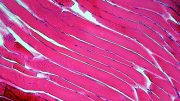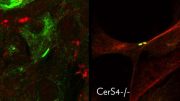
Ceramides are a type of lipid that play a vital role in maintaining the integrity and function of the skin barrier. They are a key component of the skin’s natural hydration system and help to retain moisture, protect against environmental stressors, and keep the skin smooth and plump. Ceramides are commonly used in skincare products, such as moisturizers and creams, to nourish and strengthen the skin barrier.
As they age, both mice and humans tend to become less active and lose muscle mass and strength. Scientists led by Johan Auwerx at EPFL have recently discovered that aging mice have an accumulation of ceramides in their muscles. Ceramides are commonly used in skincare products and are a type of sphingolipid, a class of fat molecules that perform various cellular functions rather than being used for energy production.
The researchers found that, in aging, there is an overload of the protein SPT and others, all of which are needed to convert fatty acids and amino acids to ceramides. “The sphingolipids and ceramides are complex yet very interesting fat class, and there is high potential to further study their role in aging, as they perform many diverse functions,” says Dr. Pirkka-Pekka Laurila, a medical doctor and the lead author of the study.
Next, the scientists wanted to see whether reducing ceramide overload could prevent age-related decline in muscle function. They treated old mice with ceramide blockers, such as myriocin and the synthetic blocker Takeda-2, and used adeno-associated viruses to block ceramide synthesis specifically in muscle. The ceramide blockers prevented loss of muscle mass during aging, made the mice stronger, and allowed them to run longer distances while improving their coordination.
To study this effect more deeply, the scientists measured every known gene product in the muscle using a technique called RNA sequencing. “It turned out that blockade of ceramide production activates muscle stem cells, making muscles build up more protein and shifting fiber type towards fast-twitch glycolytic to produce larger and stronger muscles in aged mice,” explains Dr. Martin Wohlwend, the main collaborator in the study.
Finally, the scientists looked at whether reducing ceramides in muscle could also be beneficial in humans. They examined thousands of 70-80-year-old men and women from Helsinki and discovered that 25% of them have a particular form of a gene that reduces the gene products of sphingolipid production pathways in muscle. The people who had this ceramide-reducing gene form were able to walk longer, be stronger, and were better able to stand up from a chair, indicating healthier aging, similar to mice treated with ceramide blockers.
“These findings are very important as they provide us with a strong incentive to develop inhibitors which could be tested in humans,” says Johan Auwerx. The scientists are now embarking on collaborations with the pharmaceutical industry.
Reference: “Sphingolipids accumulate in aged muscle, and their reduction counteracts sarcopenia” by Pirkka-Pekka Laurila, Martin Wohlwend, Tanes Imamura de Lima, Peiling Luan, Sébastien Herzig, Nadège Zanou, Barbara Crisol, Maroun Bou-Sleiman, Eleonora Porcu, Hector Gallart-Ayala, Michal K. Handzlik, Qi Wang, Suresh Jain, Davide D’Amico, Minna Salonen, Christian M. Metallo, Zoltan Kutalik, Thomas O. Eichmann, Nicolas Place, Julijana Ivanisevic, Jari Lahti, Johan G. Eriksson and Johan Auwerx, 16 December 2022, Nature Aging.
DOI: 10.1038/s43587-022-00309-6
The study was funded by EPFL, the European Research Council, the Swiss National Science Foundation (SNSF), Fondation Suisse de Recherche sur les Maladies Musculaires (FSRMM), Fondation Marcel Levaillant, the Academy of Finland, the Finnish Diabetes Research Society, the Folkhälsan Research Foundation, the Novo Nordisk Foundation Center for Basic Metabolic Research, Finska Läkaresällskapet, the Finnish Foundation for Cardiovascular Research, the Juho Vainio Foundation, the Signe and Ane Gyllenberg Foundation, the University of Helsinki, the Sigrid Juselius Foundation, the Finnish Ministry of Education, the Ahokas Foundation, the Emil Aaltonen Foundation, the Paavo Nurmi Foundation, the Orion Foundation, and a Scottish Senior Clinical Fellowship.









How do you get into testing.